Struggling to edit text in images or adjust image colors without losing quality? In 2025, AI tools like Qwen Image Edit and Flux Kontext stand out as top contenders among the best apps to edit images. Both have sparked significant discussion in AI communities for their innovative capabilities, simplifying edits through intuitive text prompts—no manual brushes or complex tools required.
Qwen Image Edit, built on the 20B Qwen-Image foundation, uses a dual-system architecture: Qwen2.5-VL for semantic control (understanding context) and a VAE Encoder for appearance preservation (maintaining visuals and style). This achieves state-of-the-art performance, with features like dual modes for big-picture changes (e.g., style transfers) or fine details (e.g., edit image color on single objects), precise bilingual text editing that seamlessly matches fonts and backgrounds, and chained editing for iterative refinements—all controlled via simple text prompts.
Flux Kontext, developed by Black Forest Labs, leverages multimodal flow matching architecture for smooth, context-aware transformations that preserve character consistency, spatial relationships, and styling. As an image-to-image AI, it enables collaborative workflows where text prompts guide realistic changes, such as maintaining lighting during modifications, making advanced edits effortless compared to traditional methods.
This blog tests their image editing capabilities across multiple dimensions to help you choose. MimicPC has integrated both models, allowing you to use and test them simultaneously. Try to use these image editing models on MimicPC now!
Head-to-Head Comparison: Qwen Image Edit vs. Flux Kontext
In this head-to-head, we put Qwen Image Edit and Flux Kontext Pro to the test using the same base image and identical prompts for each category. This ensures an apples-to-apples comparison, highlighting how each tool handles real-world editing tasks.
1. Editing Text in Images
We compare accuracy in replacing or adding text while preserving fonts, styles, and context.
Prompt 1: Replace "GALACTIC ODYSSEY" with "FLUX KONTEXT"/"QWEN IMAGE".
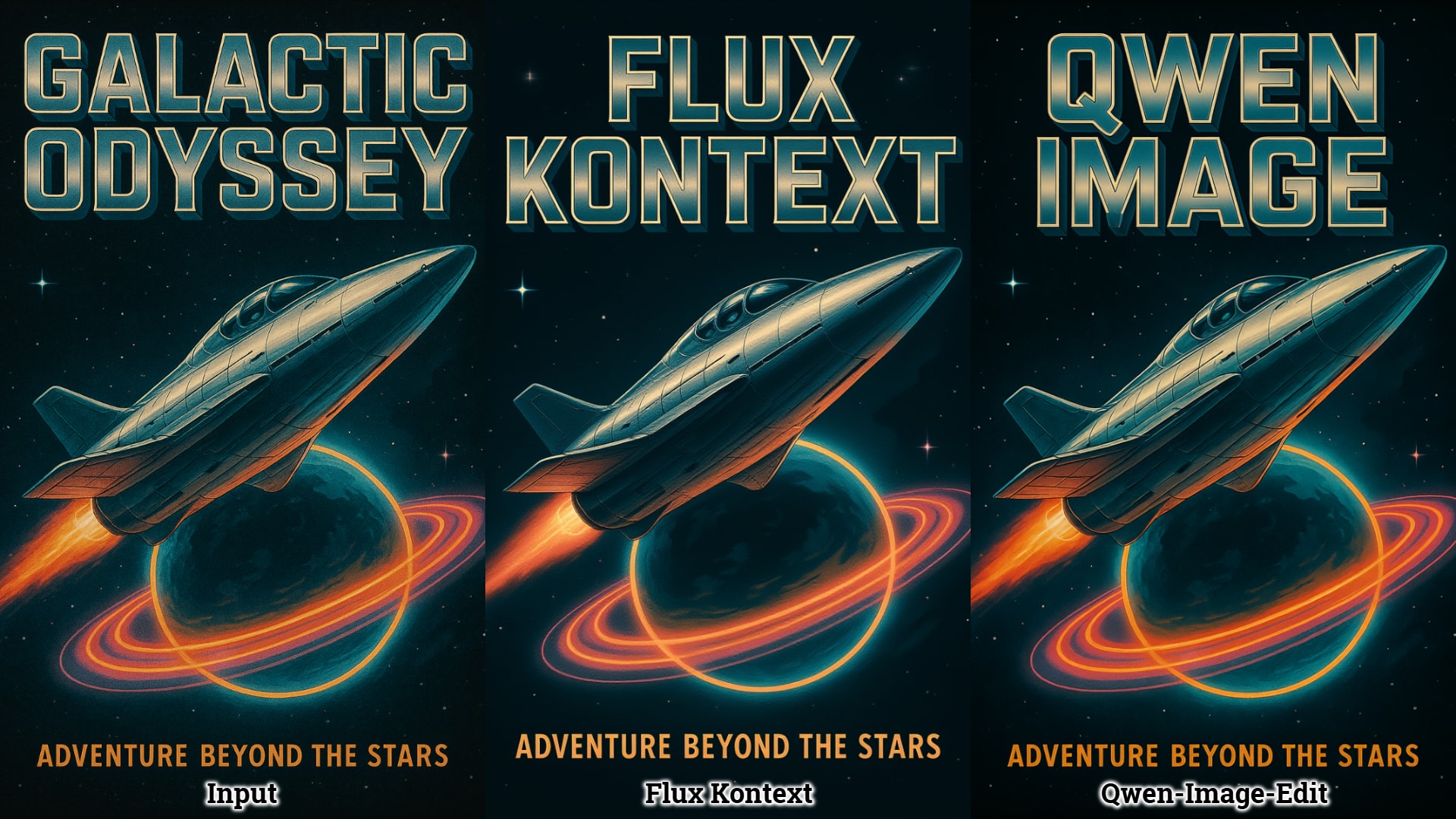
Prompt 2: Change the text to "Buy 1 Get 1 Free on All Drinks".

Prompt 3: Replace the text "Buy 2 Get 1 Free on All Snacks" with "Buy 2, Get 50% OFF, on All Drinks", while keeping other elements the same, preserving fonts, styles, and context.

In our tests, both models handle simple poster title swaps effectively, but they struggle with more complex text edits. Flux Kontext requires very clear prompts for control—if you vaguely say to change text content like in Prompt 2, it overhauls the entire design and text, but with specific instructions on what to modify, it performs excellently. Qwen Image Edit, however, shows minor font clarity issues (e.g., "drink" looks blurry) and can't accurately rewrite the exact text as requested. Overall, with detailed prompts, Flux Kontext edges out in completeness, precision, and fidelity for text modifications.
2. Editing Image Colors
We evaluate realism in color adjustments, gradients, and mood changes.
Prompt: Change her hair color to blond.
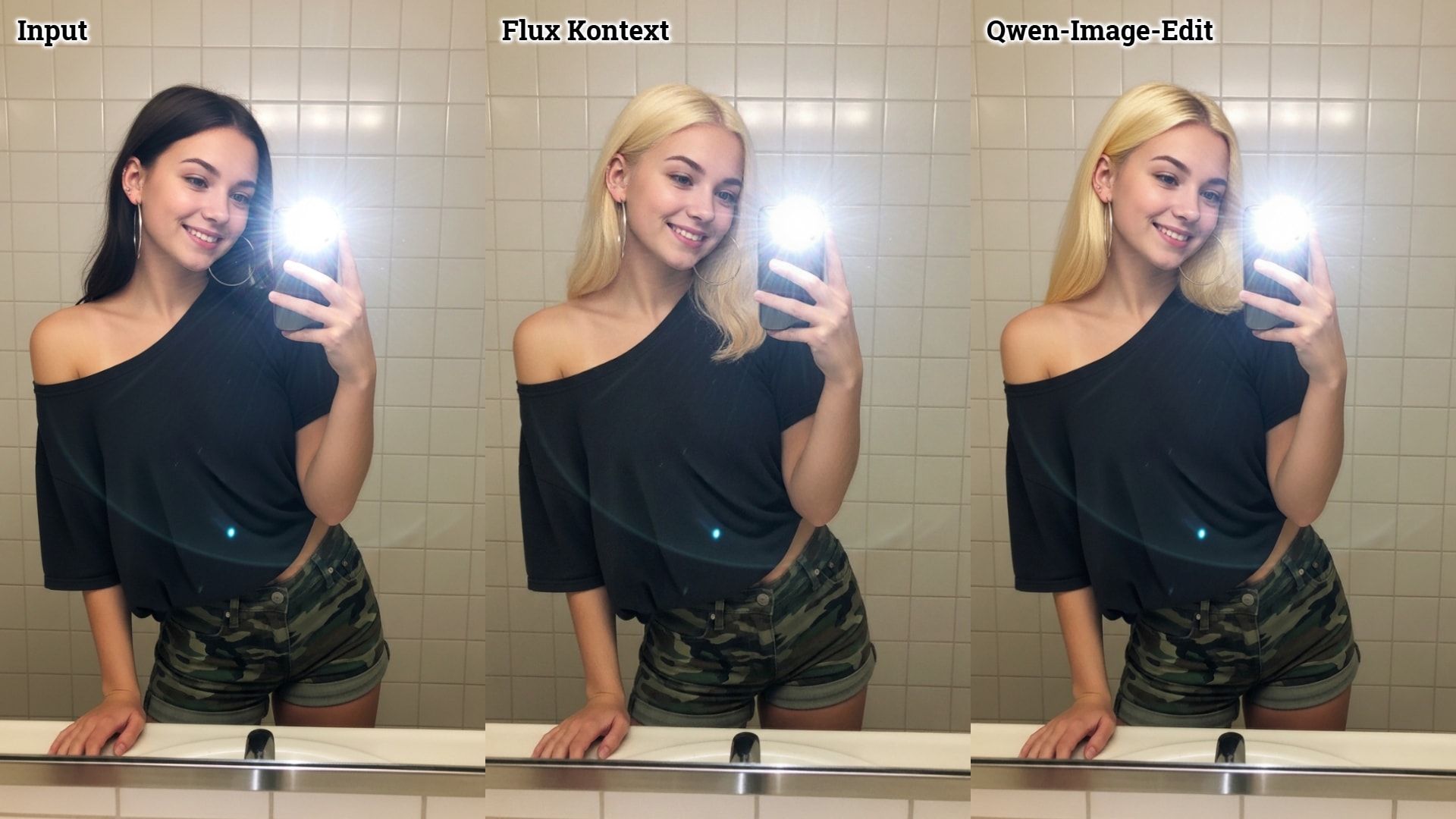
Both tools handle color changes quite well in our testing, producing realistic results. However, Flux Kontext introduces slight unintended modifications to the overall photo, like minor shifts in lighting or details. This makes Qwen Image Edit slightly superior, as it delivers cleaner, more targeted tweaks without extra alterations.
3. Object Addition
We assess how well each tool integrates new objects into scenes (e.g., adding furniture or elements seamlessly).
Prompt: Redesign this bedroom into a tranquil sanctuary by placing a low-profile platform bed directly beside the floor-to-ceiling window, maximizing the outdoor view without altering the window’s size or frame. Use layered, neutral textiles (linen bedding, wool throws) and a minimalist headboard that doesn’t block natural light. On the opposite wall, incorporate built-in wardrobe storage (floor-to-ceiling, recessed to avoid protrusions) and a small seating nook if space allows. Keep walls in a soft white or warm off-white shade to brighten the room, and add ambient lighting (pendant lights or wall sconces) connected to existing electrical points. Ensure all furniture layouts maintain clear pathways and preserve the original room structure. Provide renderings highlighting the bed’s alignment with the window, unobstructed sightlines, and a clutter-free aesthetic.
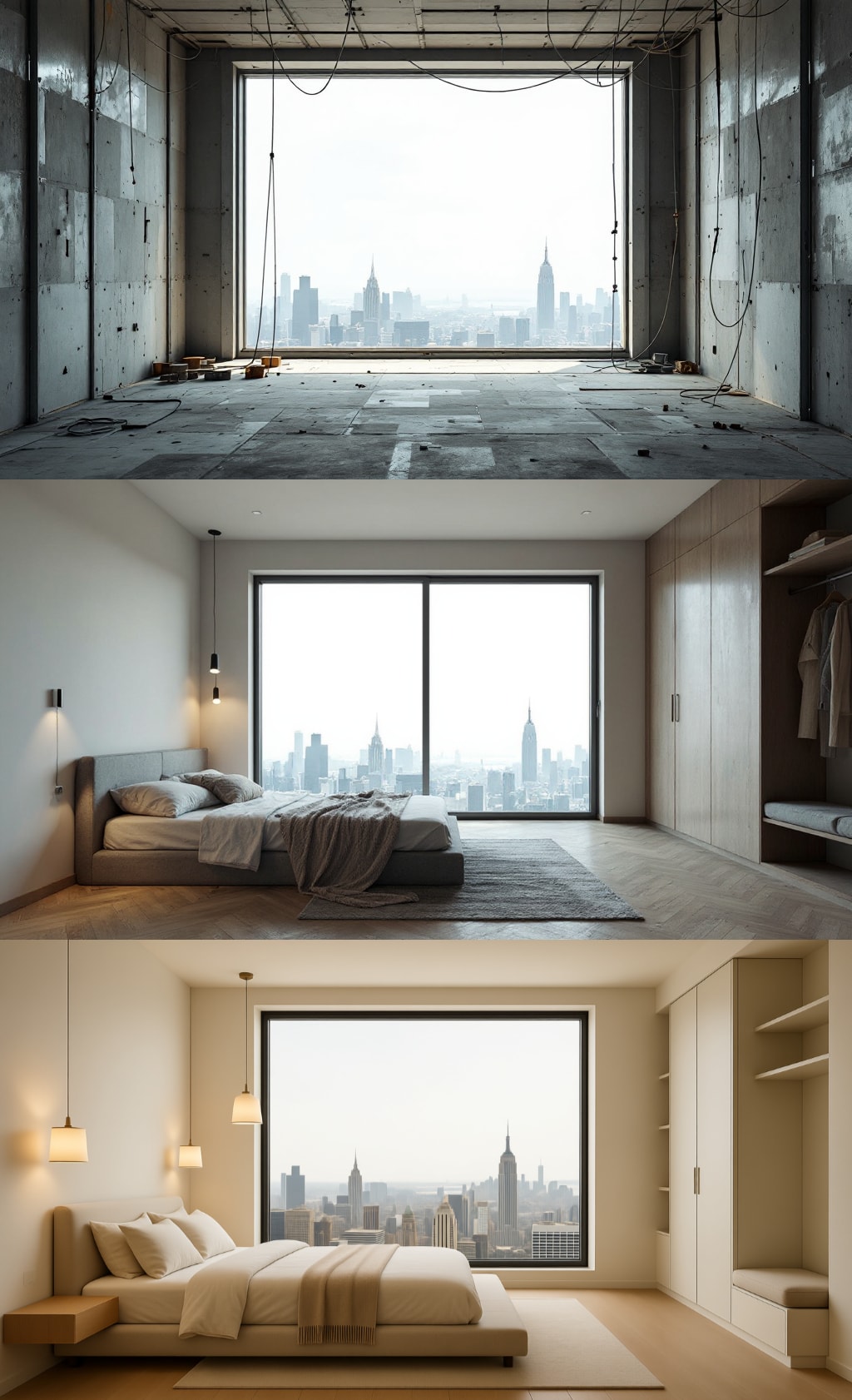
Using an interior design scenario, both models preserved the room's structure and window view consistency admirably. That said, they both had issues with spatial awareness—for instance, placing a wardrobe in a wall spot that logically couldn't extend inward. Beyond that, Qwen Image Edit controlled lighting better, adhering to the prompt's warm tones for a cohesive feel. Flux Kontext, while sometimes off on warmth, produced a more realistic overall texture and material quality.
4. Object Removal
We compare the effectiveness in erasing elements intelligently.
Prompt: Remove the leaf from her face, making sure to keep her facial features and expression exactly the same.
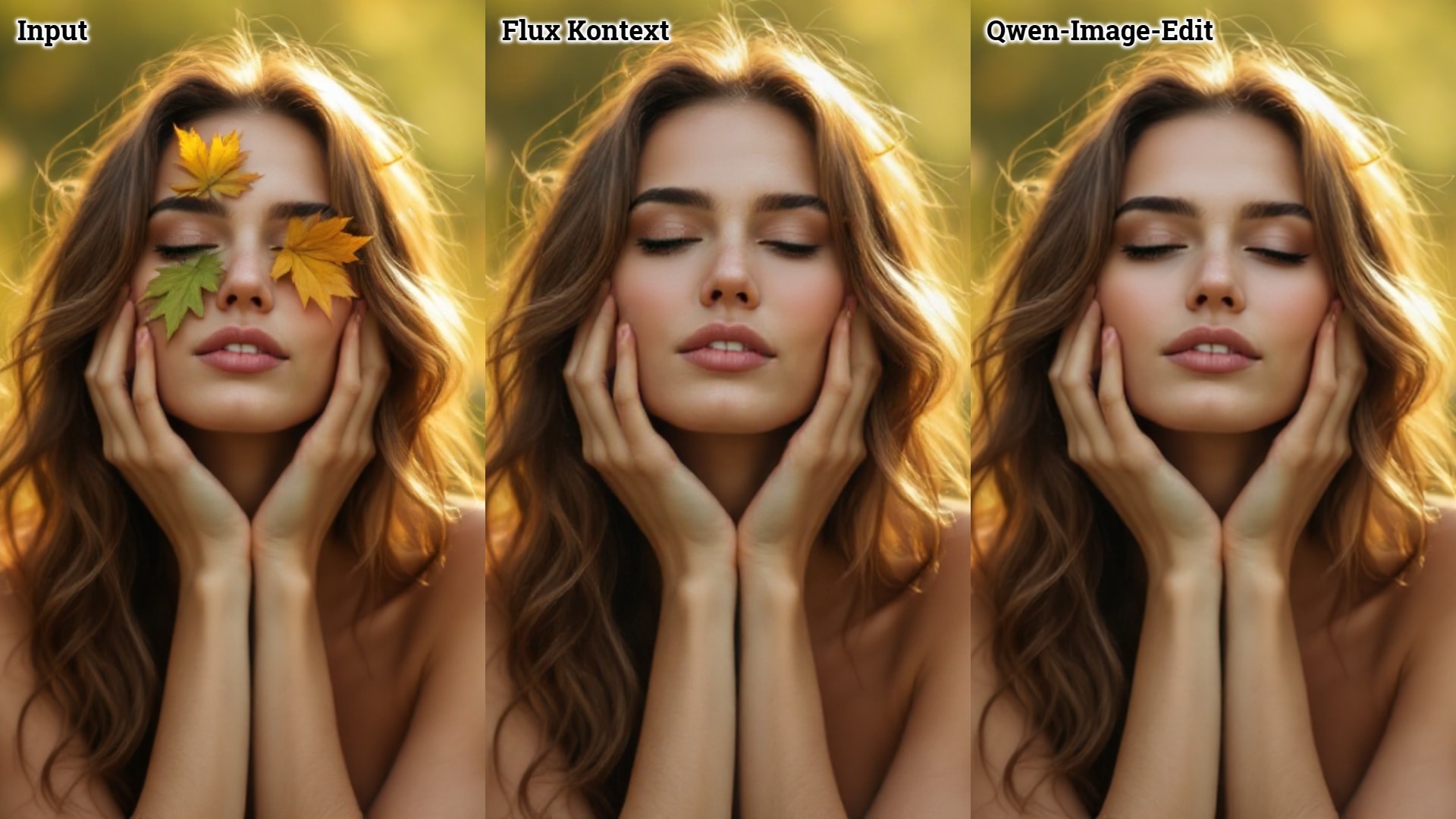
In our tests, both models excelled at removing the obstructing leaf from the face, intelligently filling the space while preserving facial features and expressions without any noticeable seams or distortions. It's a tie here, as neither introduced artifacts or inconsistencies.
5. Style Transfers
We focus on applying artistic styles (e.g., turning photos into anime style).
Prompt: Turn this image into Ghibli style.
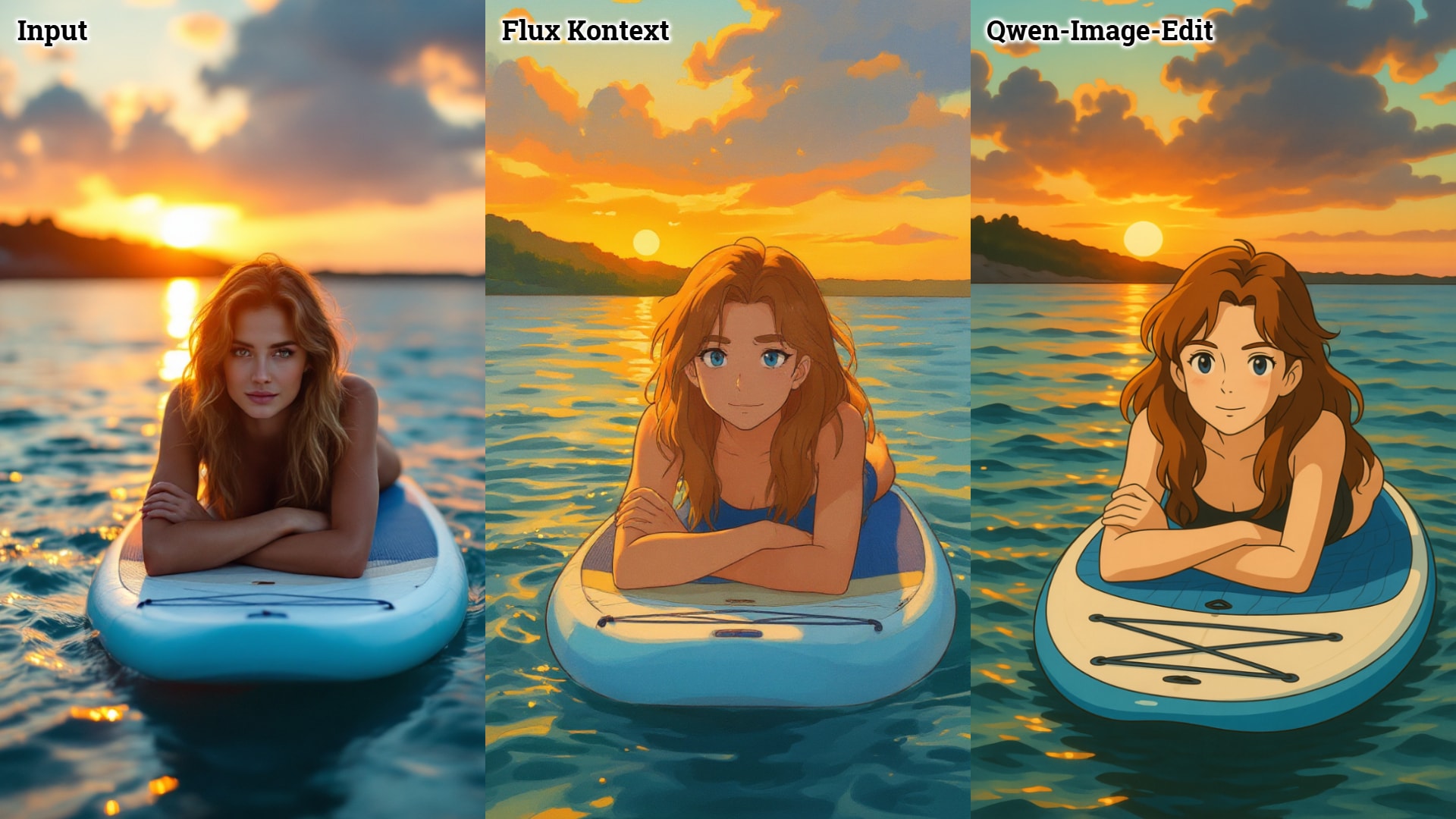
Qwen Image Edit captured the Ghibli style more authentically in our testing, aligning closely with the prompt's whimsical, hand-drawn aesthetic. However, it introduced an unwanted rotation to the subject (e.g., tilting the person and paddleboard slightly off-center from the original front-facing view). Flux Kontext avoided this rotation issue entirely, maintaining the composition, but its output leaned more toward a generic Japanese anime look rather than true Ghibli essence.
6. Changing Lighting Conditions
We evaluate adjustments to light sources, shadows, or time-of-day effects (e.g., day to night).
Prompt: Change to night light.
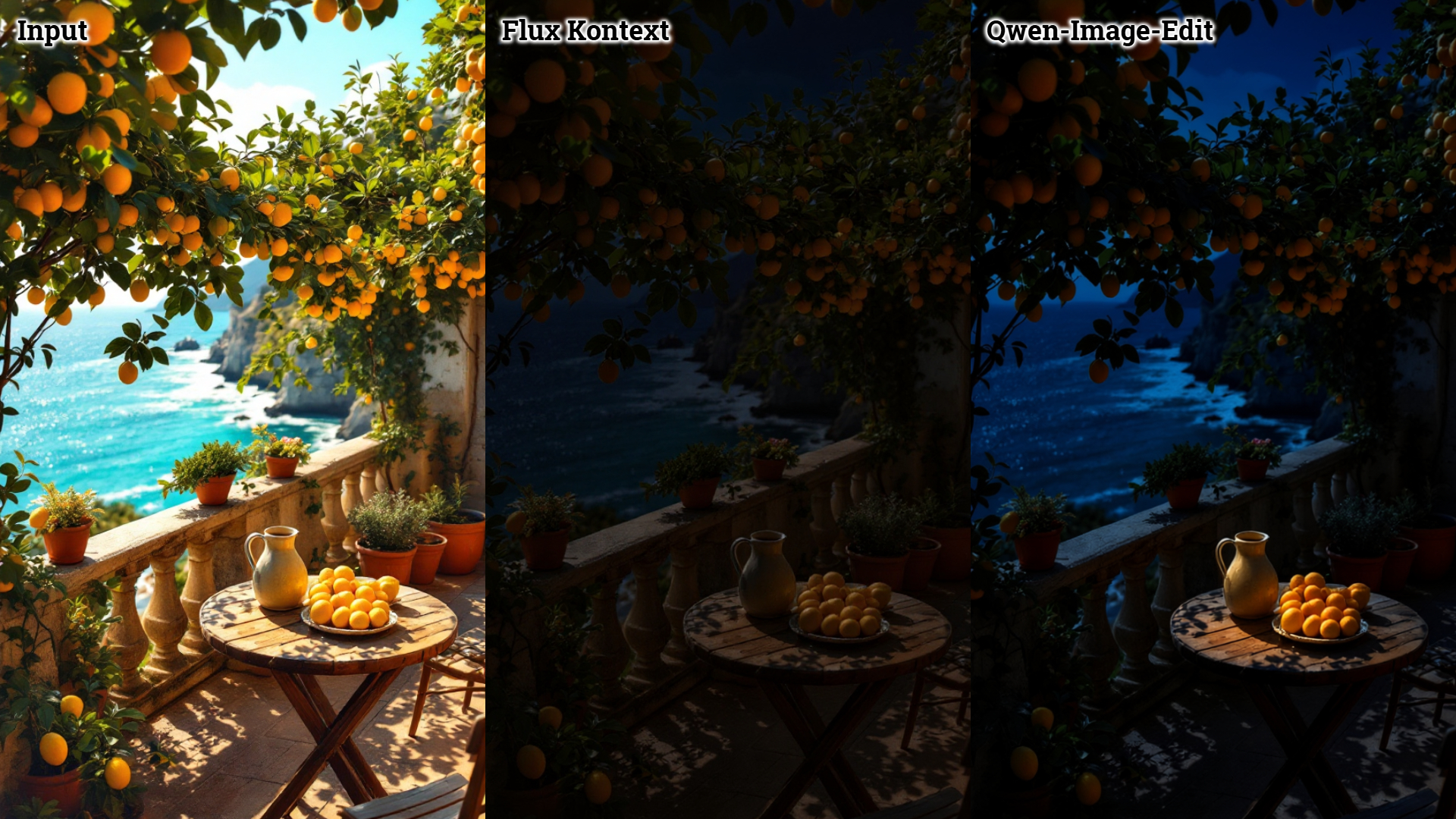
Qwen Image Edit performed better overall, transforming daylight to night naturally with added aesthetic touches like a soft lamp glow on the subject, creating a beautiful and immersive result. Flux Kontext, in contrast, simply darkened the scene in a rigid way, lacking nuance and feeling flat or lifeless.
7. Perspective Shift
We compare altering image viewpoints or angles (e.g., rotating a scene or changing camera perspectives).
Prompt: Obtain left-side view/Obtain right-side view.
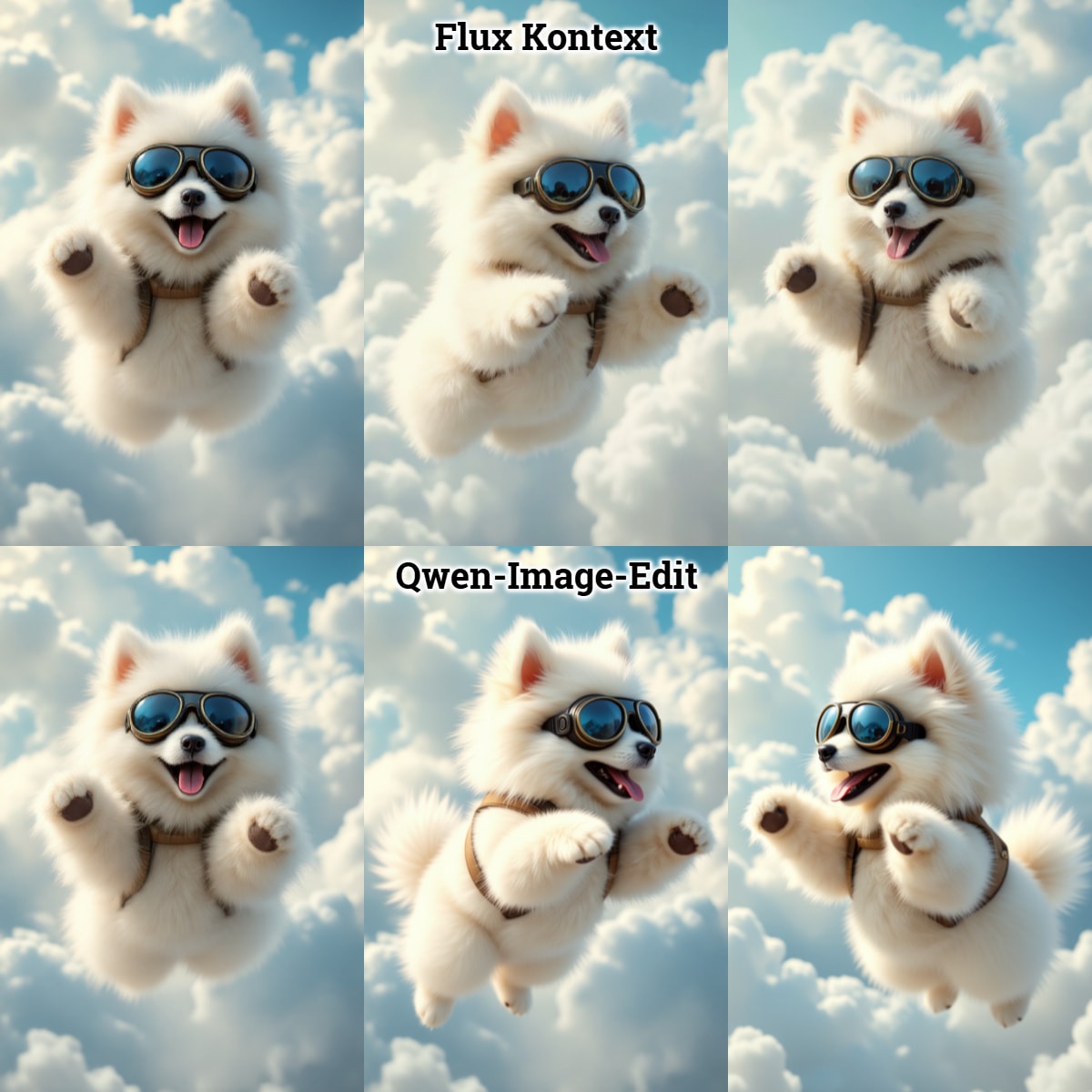
Qwen Image Edit handled this more effectively, generating clear and accurate left- and right-side views with good stability. Flux Kontext was less reliable, producing inconsistent or distorted results. That said, both models occasionally mixed up left and right orientations, which could be frustrating in precise tasks.
8. Change Image Background
We analyze swapping or generating new backgrounds while keeping foregrounds intact.
Prompt: Change the background to a magnificent palace.
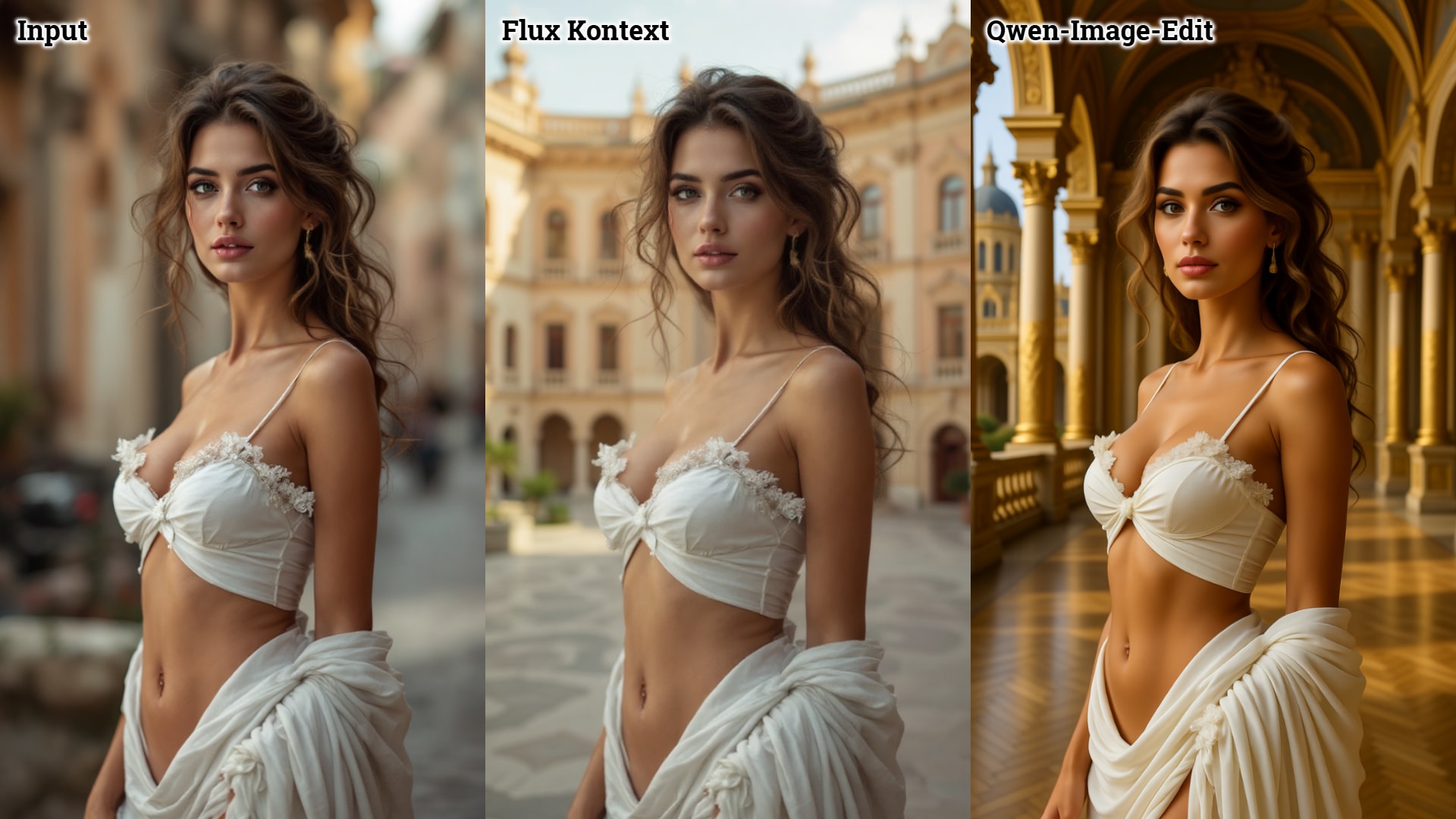
When simply asked to replace the background, Qwen Image Edit failed to maintain subject consistency—often altering the person's face or features noticeably. Flux Kontext, however, succeeded on both fronts: it generated a creative palace background while perfectly preserving the foreground subject's identity and details.
9. Virtual Try-On/Clothes Changer
We examine simulating clothing changes on figures (e.g., trying on virtual outfits).
Prompt: Replace the current outfits worn by all visible subjects in this photo with a traditional Chinese red Qipao, while maintaining perfect anatomical proportions and realistic fabric behavior. The new clothing should integrate seamlessly by: preserving the original body poses exactly as photographed; matching the existing lighting and shadows perfectly; maintaining natural fabric wrinkles and folds; and appearing as if originally worn in the shot. Pay special attention to realistic details like proper sleeve/hem lengths, collar positioning, and accessory placement. Keep the background and all non-clothing elements completely unchanged for a flawless, natural-looking result that maintains photo realism.
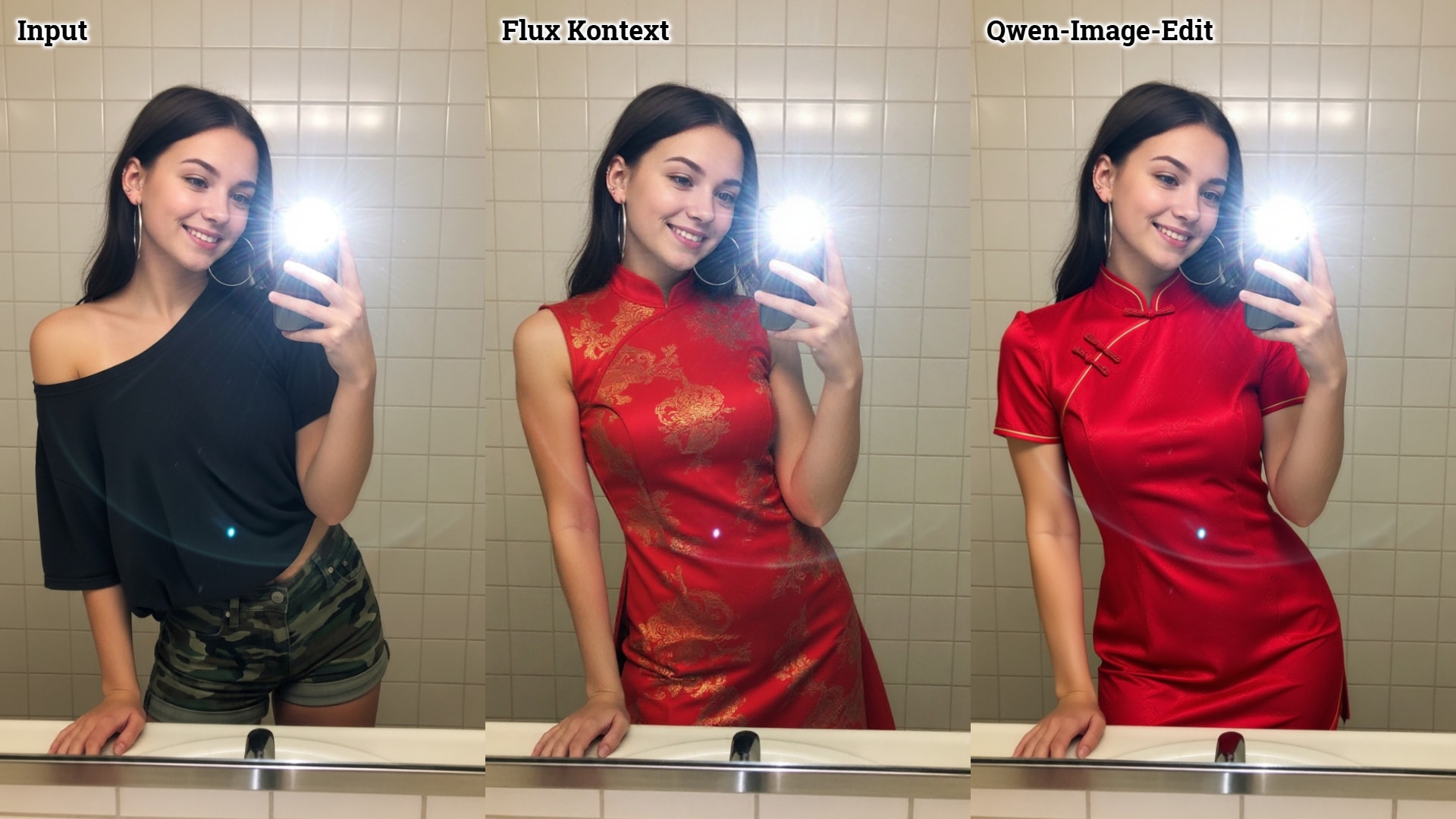
Both models performed exceptionally well in swapping outfits to a red Qipao, maintaining subject consistency, proportions, and realism—largely thanks to the detailed prompt. They handled fabric textures, lighting, and poses seamlessly, making this a strong suit for either tool in fashion-related edits.
Category | Qwen Image Edit | Flux Kontext Pro | Winner |
Editing Text in Images | Handles simple swaps but shows font blurriness (e.g., "drink") and inaccurate rewrites; struggles with complex details. | Requires clear prompts; overhauls if vague but excels in completeness and precision with specifics. | Flux Kontext Pro |
Editing Image Colors | Clean, targeted changes without unintended modifications. | Good realism but introduces slight photo alterations. | Qwen Image Edit |
Object Addition | Better lighting control (e.g., warm tones as prompted); preserves structure but spatial issues (e.g., wardrobe placement). | More realistic textures and quality; preserves structure but same spatial issues. | Flux Kontext Pro (for realism) |
Object Removal | Excellent removal of obstructions (e.g., leaf) while preserving features and expressions. | Excellent removal of obstructions while preserving features and expressions. | Tie |
Style Transfers | More authentic to Ghibli style but introduces unwanted subject rotation. | Maintains composition without rotation but results in generic anime look. | Qwen Image Edit (for style accuracy) |
Changing Lighting Conditions | Natural day-to-night shift with aesthetic touches (e.g., soft lamp glow). | Rigid darkening; lacks nuance and feels flat. | Qwen Image Edit |
Perspective Shift | Clear, stable left/right views; occasional left-right mix-up. | Less stable and consistent; occasional left-right mix-up. | Qwen Image Edit |
Change Image Background | Replaces background but fails to maintain subject consistency (e.g., face changes). | Creative replacement while perfectly preserving subject consistency. | Flux Kontext Pro |
Virtual Try-On/Clothes Changer | Handles swaps well with detailed prompts; maintains consistency and realism. | Handles swaps well with detailed prompts; maintains consistency and realism. | Tie |
Prompt Understanding | Better overall interpretation and adherence to prompts, even with less detail. | Requires very clear and detailed prompts to avoid overhauls or inconsistencies. | Qwen Image Edit |
Character Consistency | Maintains good fidelity but may introduce variations in faces or poses across edits. | Superior preservation of human figures (e.g., faces, identities) across multiple edits. | Flux Kontext Pro |
Overall, based on our real-world tests, Qwen Image Edit emerges as the slight winner for most everyday tasks, excelling in prompt understanding, natural lighting changes, and precise edits like color adjustments or perspective shifts—making it more affordable and simpler for beginners or casual users who want quick, reliable results without complex prompts. Flux Kontext Pro, however, shines brighter for advanced creative work, with superior character consistency, realistic textures in object addition, and seamless background changes, though it demands detailed prompts to avoid inconsistencies. Recommend Qwen for hobbyists and starters seeking user-friendly editing (e.g., via MimicPC integrations), and Flux for pros needing high-end flexibility in iterative or artistic projects.
If you're a beginner seeking simple, affordable tools for precise color tweaks and natural lighting changes using simple text prompts, try Qwen Image Edit on MimicPC today and see the difference.
For advanced creators needing precise text editing and character consistency in creative workflows, dive into Flux Kontext Pro on MimicPC now and unlock your artistic potential.
Conclusion
In our in-depth comparison of Qwen Image Edit and Flux Kontext Pro, both models demonstrate impressive capabilities in transforming an input image through AI-driven edits on existing images. Qwen Image Edit stands out for its strong visual appearance control, enabling natural adjustments like lighting shifts and color tweaks while maintaining realism and prompt adherence—ideal for precise, everyday modifications without unintended changes. Flux Kontext Pro, on the other hand, excels in enabling precise text editing with detailed prompts, superior character consistency, and creative image generation for elements like backgrounds and textures, though it requires clearer instructions to avoid overhauls. Overall, real-world tests show Qwen as more beginner-friendly for stable, subtle edits, while Flux shines in advanced, artistic scenarios demanding flexibility and fidelity.
Try Qwen Image Edit for simple but exact image edits on MimicPC today.
Try Flux Kontext Pro for superior editing and creative workflows on MimicPC now.
